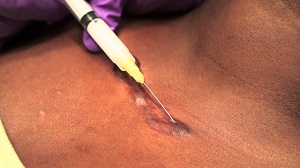Intralesional injections are a treatment method used in dermatology to deliver medication directly into a specific skin lesion or affected area. This technique involves injecting a medication into or just below the surface of the skin to target a localized problem. Intralesional injections are commonly used for a variety of dermatological conditions, including:
- Acne cysts: Intralesional injections of corticosteroids can help reduce inflammation and shrink stubborn acne cysts.
- Keloids and hypertrophic scars: Corticosteroid injections are frequently used to flatten and soften raised scars, such as keloids and hypertrophic scars.
- Alopecia areata: Intralesional corticosteroid injections are often employed to treat localized hair loss caused by alopecia areata, an autoimmune condition.
- Psoriasis: Intralesional injections of corticosteroids or other medications can be used to treat small, stubborn patches of psoriasis on the skin.
- Lichen planus: Corticosteroid injections can help alleviate the symptoms of lichen planus, a chronic inflammatory skin condition characterized by itchy, flat-topped, purplish bumps.
The medication used in intralesional injections may include corticosteroids, immunomodulators, or other substances depending on the specific condition being treated. The injection is typically administered by a dermatologist or healthcare professional, who will select the appropriate medication and determine the dosage based on the individual’s needs.
It’s important to note that intralesional injections should only be performed by a trained professional, as there are potential risks and side effects associated with the procedure. Your healthcare provider will discuss the benefits, risks, and potential alternatives before recommending intralesional injections as a treatment option.

